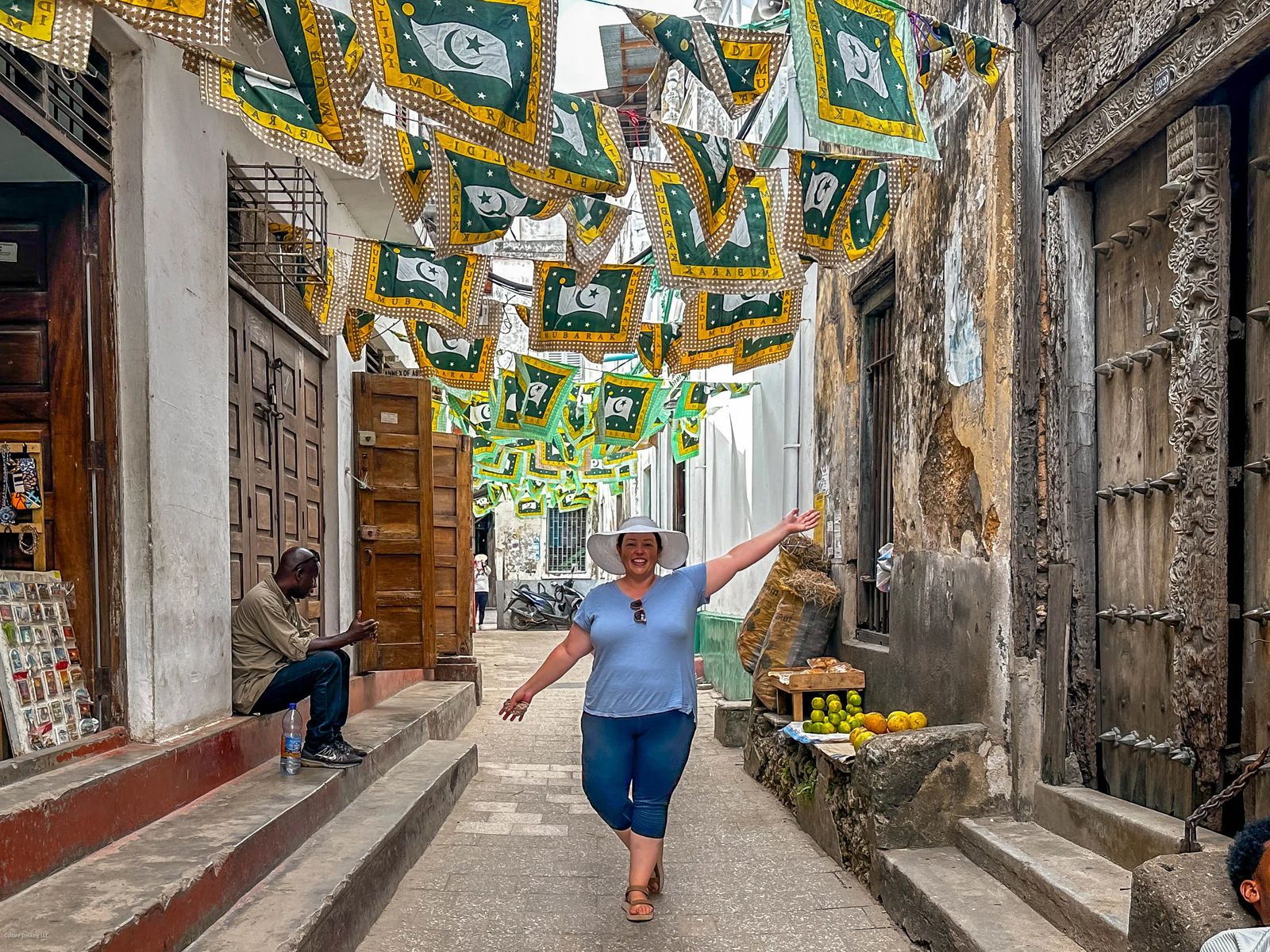
Things To See In Stonetown Zanzibar
Stonetown, a UNESCO site named for the reddish coral that used to be used to help build homes here. You can see this coral in the Dhow Palace Hotel, stay in the historic building in the center of this unique town. Learn about the history of slavery here and the effects it had on shaping Africa and the world, the civil war and efforts Zanzibar is making to gain independence. There is so much to see in Stonetown and it is certainly is worth a visit. Before you visit, I wanted to share some tips for staying healthy, things to know about getting there, ways to maximize your time, where/when to book a tour for the best experience, and so much more.
Stone Town
Also known in Swahili as Mji Mkongwe - it is located on the west coast of the island, and Zanzibar is made up of several islands like Mnemba, Mafia, and Prison island which depend big on which one you want to visit can be anywhere from $30-$70 just to visit by boat. Just keep in mind during the rainy season the rides over can be a bit rough.
The history here dates back to the 6th century BC though with Batu speakers, the pottery here ties it to archeological finds in Tanzania and so could be considered one of the earliest maritime trade routes & fishing areas. The Swahili towns here date back to the 11th century. Many of the early homes were built with clay and coral, until the Portuguese came in the 15th century and more permanent materials like lime bonding were used. Much of the architecture today is from the Omani rule though. Many buildings were made from coralline ragstone and mangrove timber, set in a thick lime mortar and then plastered and lime-washed, reflect a complex fusion of Swahili, Indian, Arab and European influences.
Formerly part of the Omani Sultanate, then one of the shortest wars happened with Britain lasting merely 45 minutes - it came under their rule and the 19th century saw both the slave and spice trade (mostly cloves) here flourish. It only became the Republic of Zanzibar in 1964 and joined Tanzania but with its own autonomous government. 20,000 people died in this revolution and thousands of people fled with nothing but the clothes on their backs.
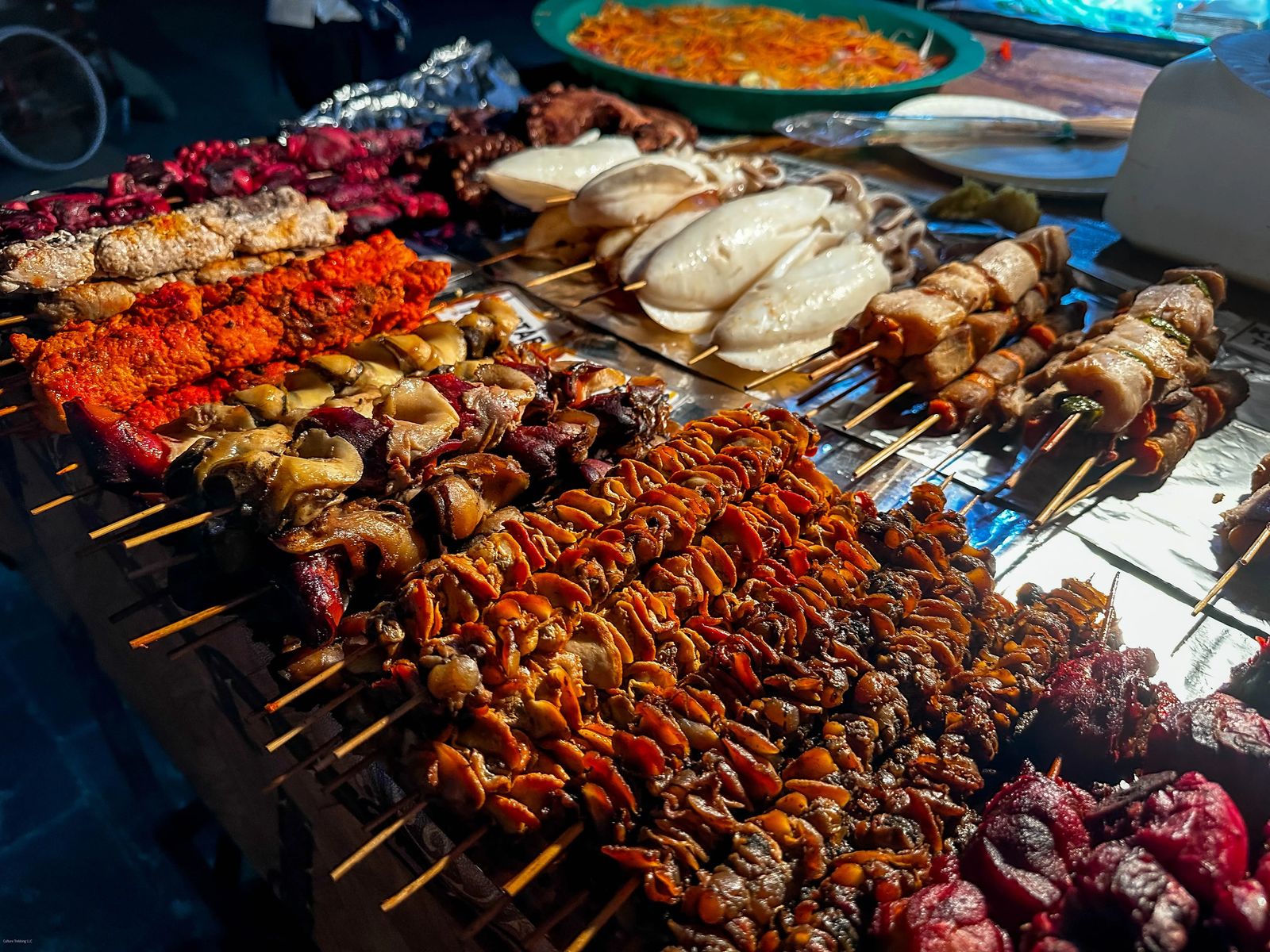
Foradani Gardens
If you are looking for nightlife, street food, and somewhere the locals hang out then Foradani Gardens is the place to go. At night the area lights up with food stalls featuring some of the best food that Zanzibar has to offer.
Some of these delectable delights include curried meat kebabs, coconut bread, sugar cane juice, local seafood of all sorts, roasted corn, samosas, gyros, pizzas, and more.
The most famous dish people get at the market is the Zanzibari Pizza, similar to a Japanese okonomiyaki - it has a smattering of meats, veggies and various spices.
Pizza and meat kebabs are typically safe to eat, and gyros - look for things that are freshly cooked. Seafood can be out for several days before being consumed, sometimes octopus skewers are pre-cooked and reheated - you don't want to eat those. As a general rule, if you can't peel it, cook it fresh, or see it being prepared it probably is best to not eat it. If there are fresh fruits, the fruits that DO NOT grow close to the ground are also safer to eat than those that do because of contaminants and parasites. When getting drinks, it is best to not have anything with ice in it - and ensure there is fresh water. In general you won't find ice in drinks alcoholic or not, but it better to not have ice as it tends to not be filtered anyway.
After your dining al fresco on the warm stones that surround the area, take a dip at sunset in the sea. You will find kids jumping off the pier, playing soccer on the beaches, bobbing in the waters to cool off from the long hot day.
The food at Foradani Gardens is quite cheap, and you do need cash - they do take US dollars, but I would recommend having local currency so you can get a better exchange rate with paying.

Angelican Church of Christ
This church was built to honor Dr David Livingston for playing an integral part of abolishing the slave trade in Zanzibar. The church itself was built over the old slave market, where slaves were kept in the basement with stifiling conditions, little room, for days on end to see which ones would survive the journey on the ships.
In the church you will find a cross made from a tree that had been near Dr Livingston's grave. You will also find the old whipping post spot.....
It is said that the slaves that cried louder would be given at a 'discounted price' as they weren't considered tough enough, or seasoned enough to be good investments.

East African Enslaved Memorial
The East African Slave Trade Exhibit stands on the grounds of one of the largest and most notorious slave markets in East Africa. This exhibition was created to commemorate the abolition of slavery and preserve the legacy of the individuals who were brought here and sold.
In the mid 19th century, Zanzibar’s streets were teeming with slaves. There were tens of thousands of slaves living on the islands or passing through, accounting for more than two thirds of the population.
Slavery had always been a component of traditional East African society. During the 19th century the trade grew into a highly lucrative business conducted by Europeans, Indians, Arabs, and coastal people and ethnic leaders of the mainland.
By 1860, residents from all levels of society benefited from the growth of slave-based economy. Enterprises were prospering. Slaves who earned wages made savings invested in slaves themselves.
Slavery in East Africa and the Indian Ocean continued unabated. Zanzibar was the centre of operations. It was another 40 years before the abolition of slave trading in East Africa was decreed by the Islands’ Omani Sultanate in 1873. Still, slavery as an institution persisted in Zanzibar until 1909. Master-slave relations and clandestine kidnappings continued at least two decades longer.
This is recent history - a history that created turmoil and division in Zanzibar society. The influx of people ultimately enriched its culture but painful memories endure leaving, both a positive and negative behind.
The exhibit is a sculpture and series of boards with photos on them, stories of slaves, their porters, the cultures and communities lost, how slavery here was established, the products that drove the slavery throughout the world, and finally the aftermath of slavery here once it was finally abolished.
It is a signficant part of history in Zanzibar and Africa and I highly encourage you to visit.
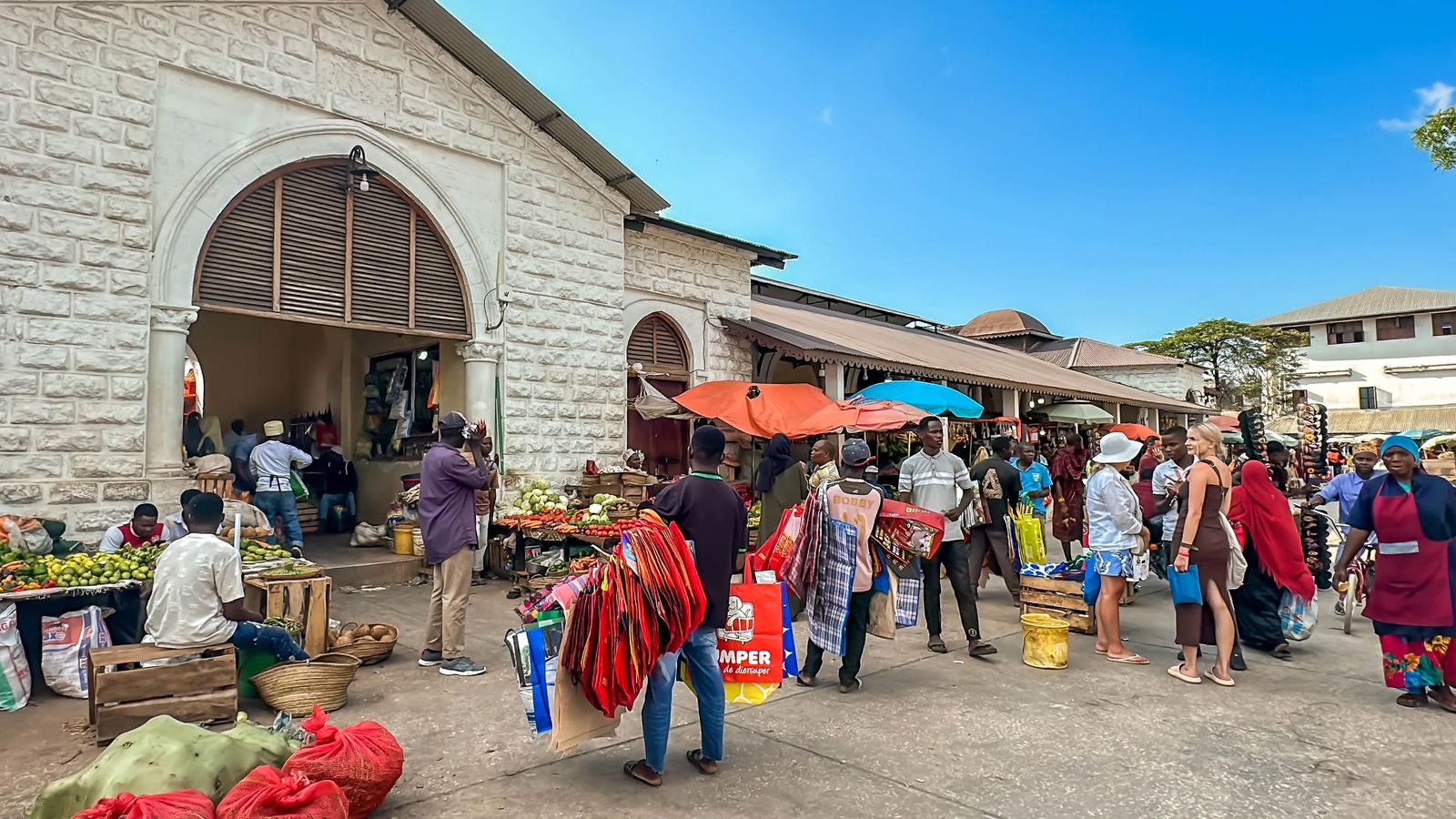
Darajani Souk (Local Market and Spices)
If you want to cook something at your accomodation, or have a hankering for fresh fruit/veggies, meats, fish, spices, teas, a plethora of coffee flavors - or any kind of recycled trinket then Darajani Market is for you.
If you plan to buy any kind of seafood, I would certainly go early in the morning as you can because that is when you will find the freshest catches - maybe even take part in the fish auction. The produce will be fresh, and won't be picked over as much - plus the cooler temperatures are a bit nicer to browse in the heat that can get quite stifling.
There are specific areas for each type of product, so plan for a few hours to browse and barter. A great way to barter, is to ask "is this the American price, or the Swahili price" - usually this produces a sly smile and they come down to something more reasonable. I've used this technique in multiple countries and seems to work every time. Personally, I also set a rule for myself - if it isn't something I can get at home, or isn't at a price I would pay at home - no matter how exotic it may seem - then just walk away. Don't feel bad for walking away, sometimes that is the best thing you can do. The only time I spend more money, if they won't come down on price as you walk away - is if I will have extreme regret not getting it or if it is something that speaks to my soul.
There are a few unique items to keep an eye out for - not just spices, tea, and coffee (which Zanzibar is known for), but also traditional clothing. There are the Islamic hats, known as Kofia - typically men wear these and they are worn to prayer. They are ornately embroidered, and can sometimes be customized for each customer right on the spot.
Other food items to keep an eye out for - sugar cane juice, soursops (Juice), Durian fruit/jackfruit (the spikey ones), pineapples, bananas, watermelons, oranges are also very common. Eel, Octopus, and Chaguu are very common fishes sold at the market and restaurants, often served in curries with rice and fresh veggies.

Freddy Mercury Home
Freddy Mercury was the lead singer for the popular band called Queen in the 1970's. He is said to have grown up in Zanzibar, right here in Stonetown in this home. His parents were British, and were stationed there to work with the British Colonial office, his father was a cashier.
Freddy would jump back and forth between Zanzibar, England, India, and back again. It wasn't until 1964 when the Zanzibar Revolution occured, that he fled to England and started Queen.
You'll find a plaque/memorial out front with some pictures of him and a few quotes (see photo). When you walk into the home you pay a small fee in cash. Then tour the museum where a you will see photos, detailed written accounts of Farrokh Bulsara (Freddy Mercury) and his journey to becoming an international star.
What many may not know is that he was a Zoroastrian, along with his parents. This religion is an offshoot from Islam, they believe more in 'be good, do good' as an overall theme, and is considered to be one of the oldest religions in the world.
Queen performed over 700 live concerts and sold 150 million albums around the world. They topped the charts in the USA and England in the 1970s-1980s. Freddy Mercury was said to have a flamboyant personality, and with his four octave vocal range was named by the Rolling Stones as one of the Top 100 singers of all time.
Full disclosure, I didn't actually go into the museum as I just didn't have the time, and don't have a personality type that fawns over celebrities personally. For those who this band means a lot to, I wanted to include a bit about it - as it is great source of pride for the people in Zanzibar.
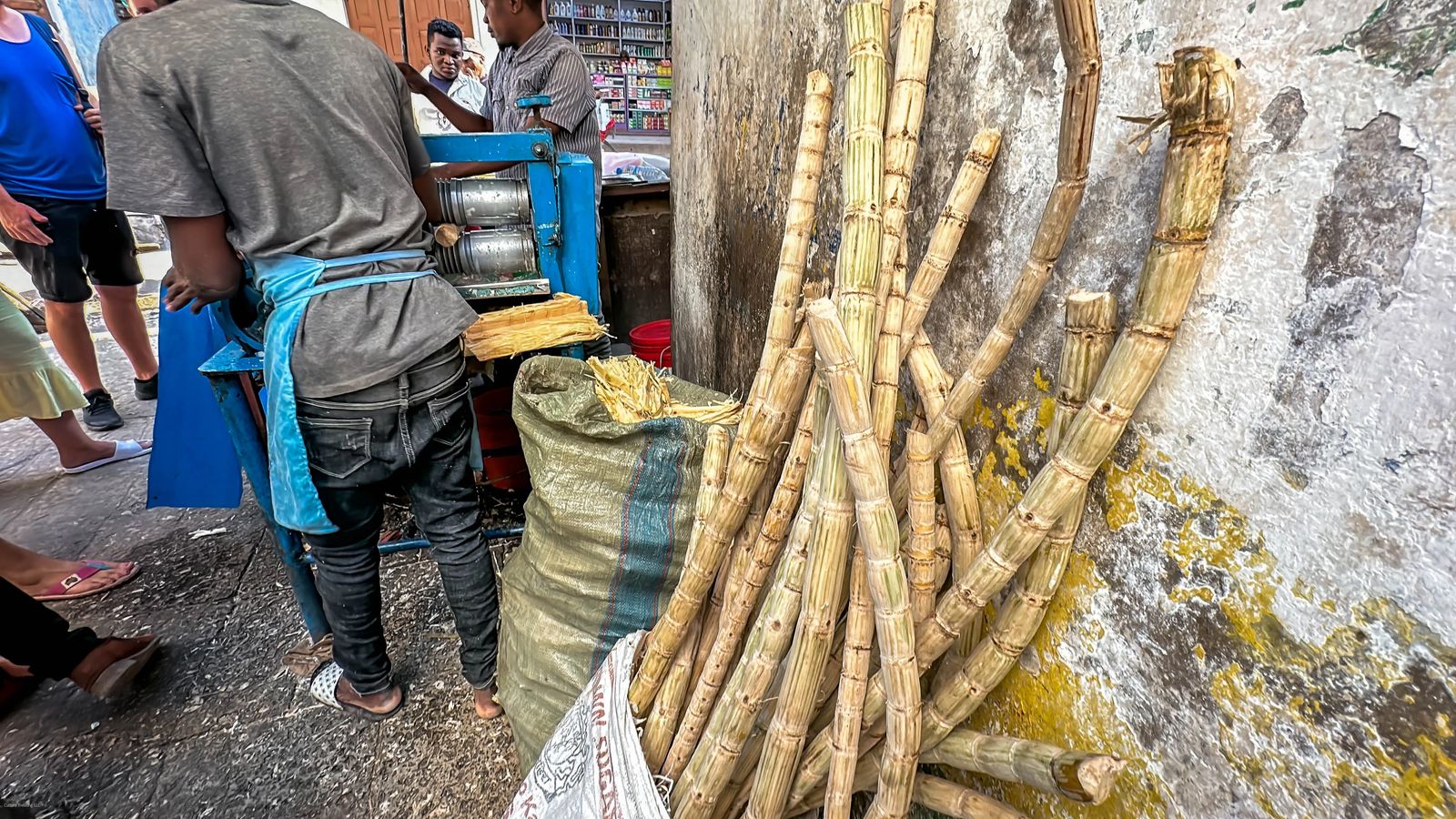
Try Sugar Cane Juice
Sugar Cane, typically thought of as singularly used to make sugar in the USA due to the Sugar Cane fields in Hawaii. However, in Zanzibar, the use the plant - squeeze it through a machine, take the juice and make a drink out of it - that surprisingly isn't sickly sweet.
As an added bonus, they often will ask if you want lime or ginger in it - for a bit of a kick. If you find a street vendor, I highly suggest drinking some. You can find the drink at many spots throughout Stonetown - they aren't hard to spo, but you will need to pay in cash. Each drink costs between 1000 TSHS (40 cents) to 4000 TSHS ($1.60) per cup, depending on the vendor and location. A good rule of thumb, if there is a line of locals - it is probably reliably good and cheap.
Despite being from the sugar cane plant, the drink is also a rich source of calcium, magnesium and other electrolytes that are quite refreshing. Especially with the sweat fest I tend to turn into in humid environments (desert gal over here) I'm all about regularly replacing electrolytes when I travel.
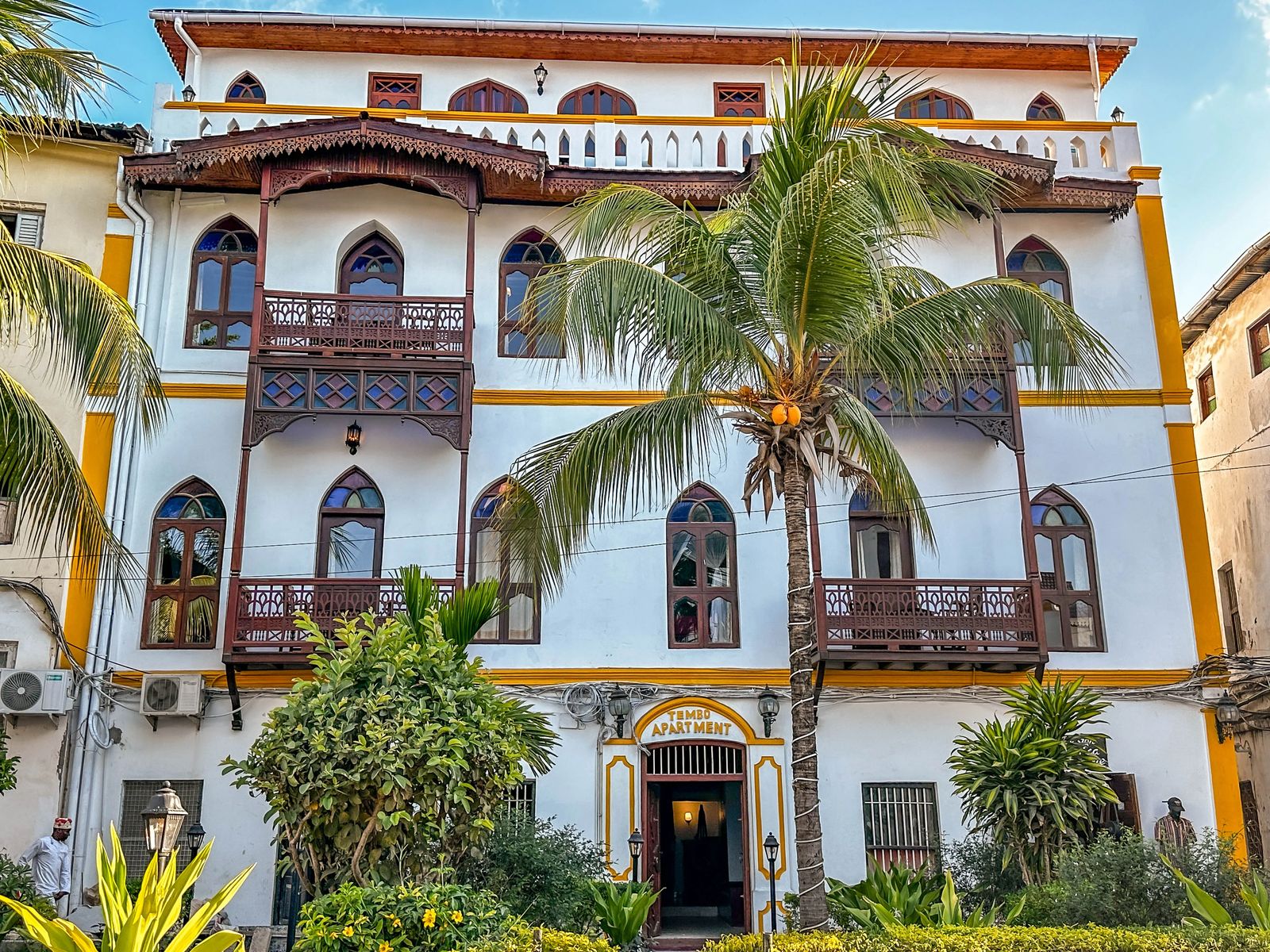
Traditional Tea & Coffee Ceremony At The Tea House
The coffee in Zanzibar is unlike any other coffee in the world, because of the tropical setting on an island, with so many fruit and spice plantations you can definitely taste notes of it in their coffee. They also incorporate those spices and fruit flavors in their coffee too. My favorites are the cardamom, mango, pineapple and clove - it is the perfect combinations of summer or Christmas. While the sachets they sell in the markets are quite small, it allows you to get multiple different flavors.
Coffee in Zanzibar is called Kahawa in Swahili, and a great way to taste the coffee and tea in the area is to go to the tea house in Stonetown. You can reserve a time to get the 1.5 hour ceremony called "Roshani". They teach you about the how coffee came to Zanzibar, the culture around drinking tea and coffee, how it is incorporated into the culture, and how traditional ceremonies are preformed for formal functions and wedding ceremonies.
You also get a 360 degree view of Stonetown high above the city. It does require a bit of stair climbing to get to the 3rd floor but it is well worth it. While I personally didn't have time to attend a tea ceremony, it is something I regret having missed - so let me know in the comments how it was for you if you go!

Doors In Stonetown
Stonetown is known for its doors, and each door tells a different story. The doors here tell a story of who lived there. Some homes have flowers, tea leaves, or even a crown on the top - for the royal crown or royal family. I highly recommend getting a guide because it is very easy to get lost in Stonetown and sometimes you miss doors or important landmarks that look non-descript on the outside but hold significance to the history of Stonetown.
The ornate designs on the doors and structure of them come from both Omani and Indian influence, two cultures that played a major role in the history here. The ornate designs and shape of the doors are more the Omani influence, while the spikes on the doors were from the Indian influence.
In India, at the time that they were also occupying Zanzibar, there were a lot of wars happening. They would put spikes on the doors in India to prevent Elephants from kicking in the doors. While Zanzibar has never seen an Elephant on its soil, you can still see so much of its influence here today.
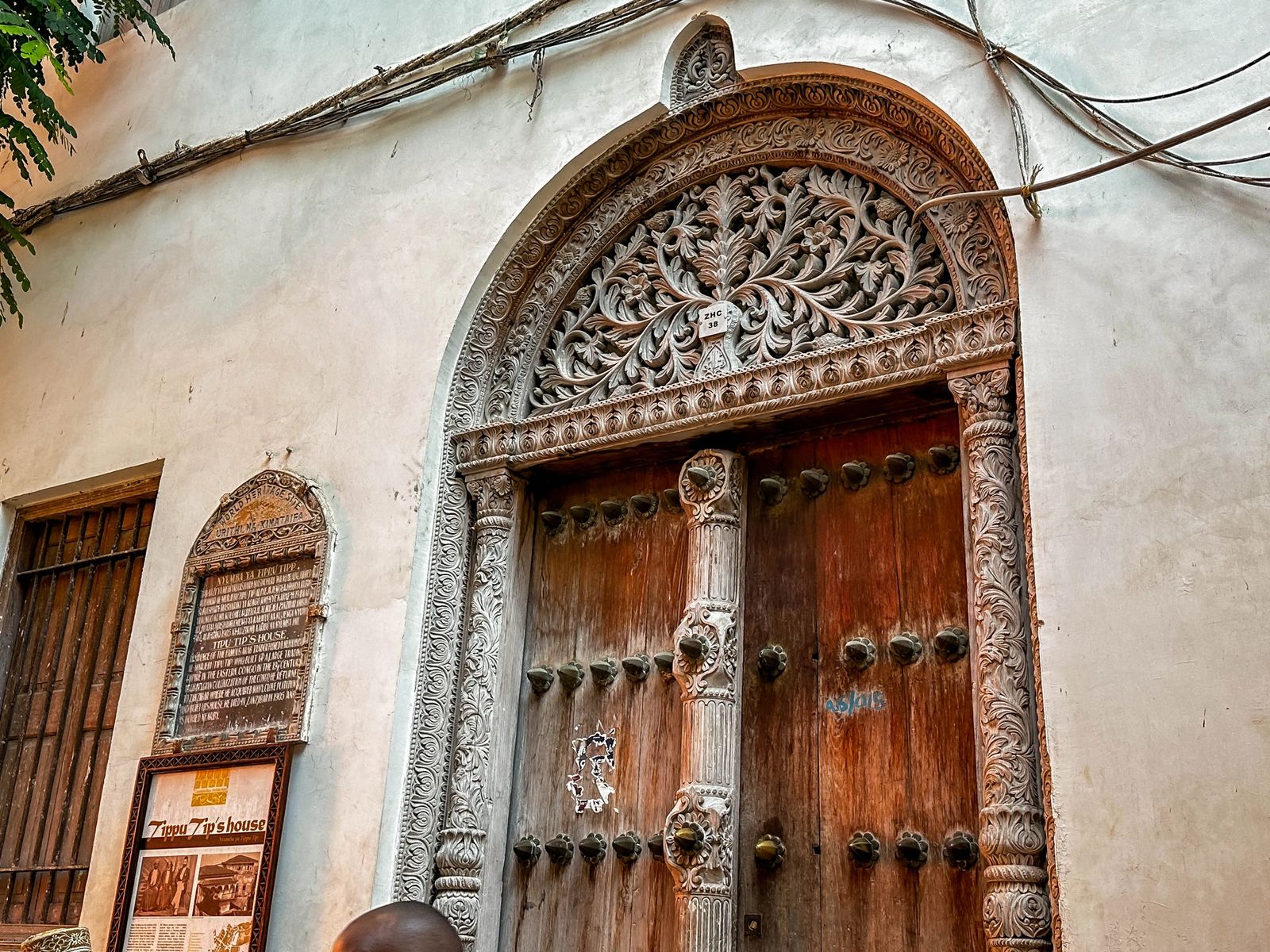
Tippie Tipu Home
Born Hamad bin Muhammad bin Jumah bin Rajab bin Muhammad bin Sa'id al-Murghabi, it is said he gained the nickname 'Tippu Tip' from the sound made by his guns. Tippu Tip's father was a native of the Swahili coast and an established trader on the caravan routes; his mother was a member of the Oman ruling class.
During the last half of the 19th century, Tippu Tip was the most powerful trader in central Africa and a leading supplier of ivory. At one time he controlled more men and weapons than all surrounding traders and tribal chiefs combined. Well known for his political and business savvy, leadership and negotiation skills, he met and assisted many European explorers on their travels and was well liked by most.
He controlled his empire with a group of loyal Arab and Swahili leaders and thousands of central African tribesmen and slaves. Leaders that did not give into his demands were replaced or faced having their food, land and people stolen or destroyed. Entire areas under his control were completely depopulated to continue the supply of ivory and slaves.
During the 1870s & 80s, he ruled over an even larger area, claiming the entire eastern Congo for himself and the Sultan of Zanzibar. Mainly interested in commercial pursuits, Tippu Tip established a monopoly on elephant hunting and ivory in his territory, constructed profitable trading posts, and began developing areas around the main Arab settlements. At the end of his reign in central Africa he was named governor of Stanley Falls District in the Congo.
Around 1890, facing pressure from the Belgians in Congo from the west and the European missionaries and Germans in the east, he retired from his life in the interior of Africa and returned to Zanzibar. By the time of his death in 1905, Tippu Tip had accumulated a fortune including seven huge clove plantations and some 10,000 slaves to work them.
Tippu Tip's territory was around and throughout the Lake Tanganyika area. It covered the entire eastern half of the Democratic Republic of Congo, where violence rules even today.
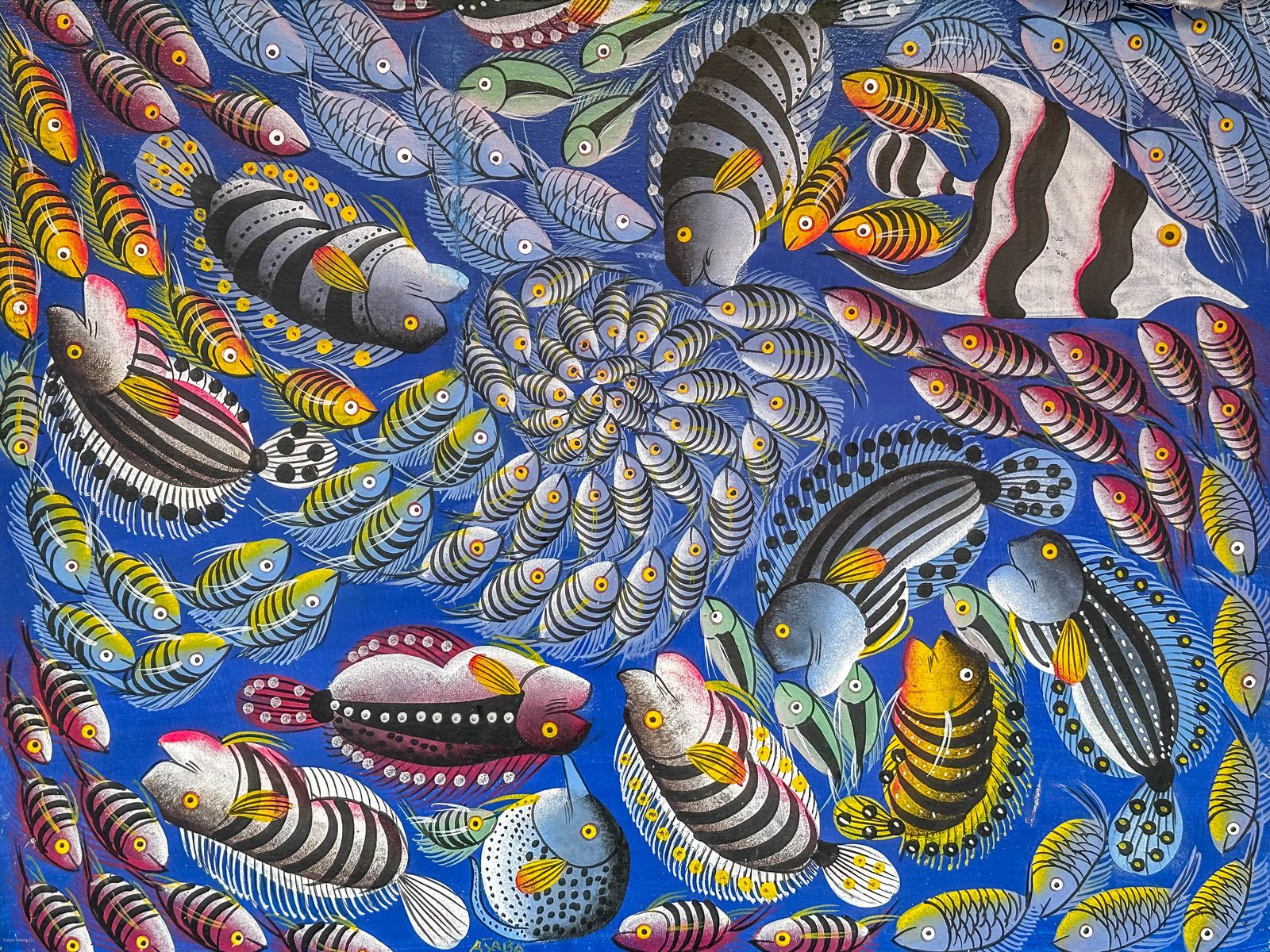
Tinga Tinga Paintings Down Painters Corridor
These characteristic paintings of animals, evil spirits, and African landscapes you will find in Tanzania, Kenya, Zanzibar and throughout East Africa. They typically look like characters or animals out of a children's book, but also can include dot like paintings and techniques see throughout. This type of painting was started by Edward TingaTinga, a Tanzanian painter, who also practiced Hinduism.
You can see his Hindu influence in the evil spirits he would paint, they typically have a dark or black face, which is similar to the evil spirit in Hindusim called Ravana. While some say that there are paintings like this documented back in 1906, it didn't become popular until Edward Tingatinga in 1978.
No matter where you go in Tanzania or Zanzibar, you can find these styles of paintings and it is a GREAT piece to add to your art collection or souvenirs because of how unique it is.
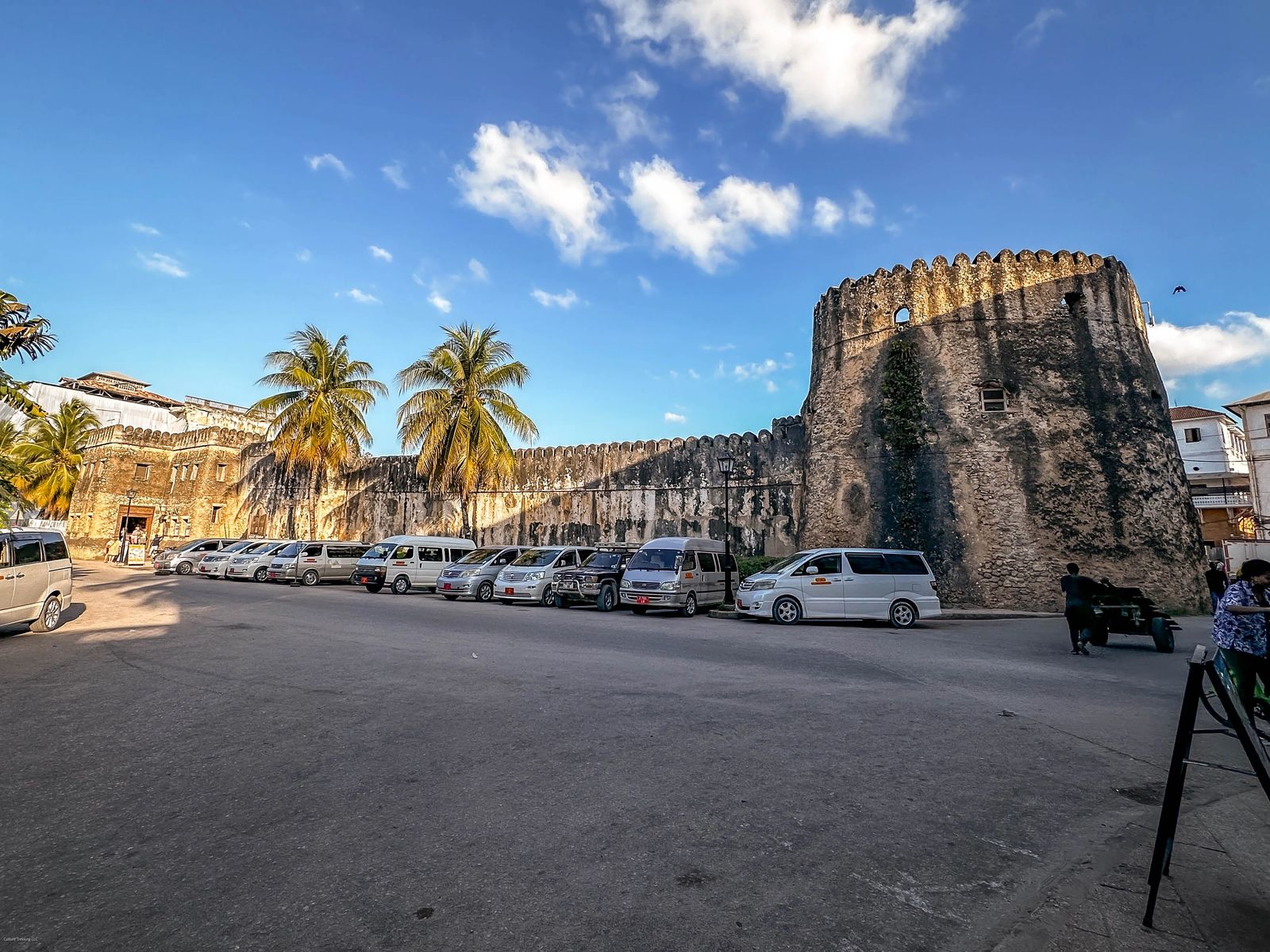
The Old Fort
Zanzibar was seized from the Portuguese in 1698 by the Omani forces, who then re-built this giant fortress to what it looks like today. It has had many different uses throughout its life, from a fortress, to a cultural center, a train station even a tennis court.
Since the 1990's an amphitheater was built inside and it officially became a cultural center, and is conveniently located right near Foradani Gardens. At the end of February you can attend Sauti Za Busara, a massive East African Music Festival. They also hold the Zanzibar International Film Festival here in August, one of the biggest festivals in East Africa.
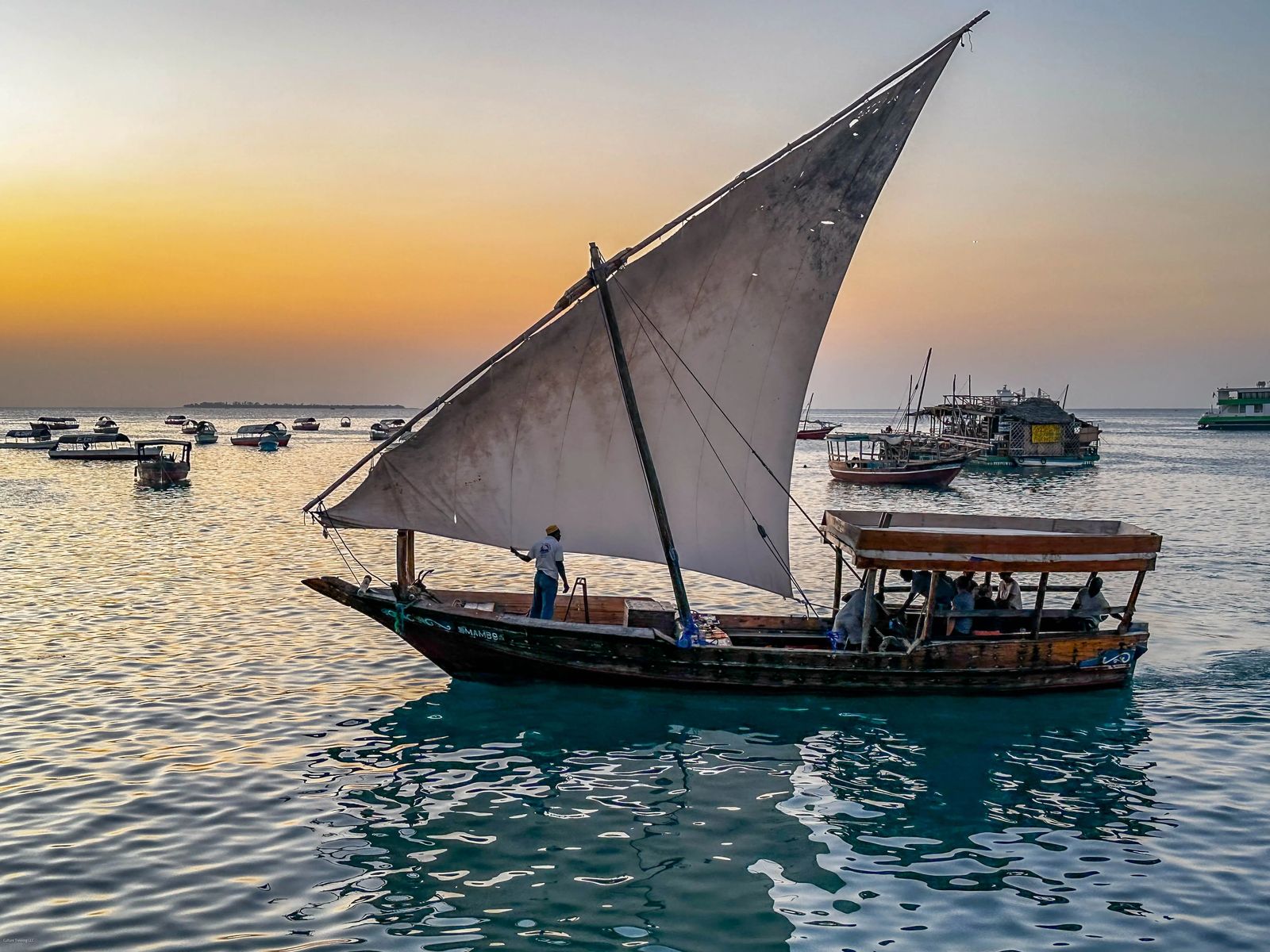
Sunset Dhow Boat Ride
These traditional wooden boats are an EXPERIENCE, don't expect the fancy treatment or water free ride. This is how the people here have sailed for thousands of years to fish, trade, and earn a living. Sunsets in Zanzibar are some of the best I have ever seen in the world (after visiting 47 countries). The combination of the blue waters, the hot humid air of the day transitioning into the cool nights with the blood red, or deep orange colors of the sunsets are incredible.
There isn't a set price for any boat, and the price is often negotiated depending on the time spent on board, what they offer on board, and if you get the Swahili price or the tourist price. I was able to find a large boat in Nungwi that had dancing, drumming, watermelon, byob type atmosphere in Nungwi for about $15-$20, I didn't try to get a boat in Stonetown though.
If you don't know where to get a sunset cruise, walk around, ask locals. Typically the hotels charge about 30% more for getting you the tour, but you usually will get someone who is registered to be a tour guide and have a bit more experience catering to tourists. If you decide to go it alone, you still may be paying 30-50% more than if you tried to negotiate a price with a few more people or a group. It is definitely worth the effort to try to go, if you have the time.
You can also go to the Traveller's Cafe, grab a pizza/pasta/burger and watch kids play soccer on the beach, watch Dhow boats sail by, and I even saw a school of dolphins playing in the waters just off the beach against the sunset.
No matter what you decide to do, must make sure you don't miss a single sunset in Zanzibar - it is unlike anything you will see. While you don't get a stellar sunset every single night, I would say 75% of the time they were breathtaking.

Spice Plantation Tour
Take the tour, it is a great opportunity to learn about the spices grown here - that played such a major role in the economy here. This really isn't something you can do on your own as the areas are highly regulated, and protected (for obvious reasons).
Most of the guides have to have have a rigorous education, equivalent to a bachelors degree in the spice plantations, plants, biology, medical uses throughout the world, and history accompanying each of the plants. I learned about a plant that in Jamaica was used to track where slaves went if they tried to escape, but in Zanzibar it is used to treat Asthma. The plant is called 'touch me not' because when you brush the leaves, or if a heavy wind blows - the leaves close up for several minutes.
We learned about Jackfruit, Bananas, pineapples, all sorts of spices and which parts of the plant are used for different reasons. It is hard to list it all here, but make sure to head to my Youtube channel to watch the whole tour.
My tour guide was a self-made woman powerhouse called "Happy Baby", she runs her own buisness bossing men around ;) - can't recommend her enough. She was accomodating with me video taping, took photos for me, gave me suggestions on the best places (and poses) for photos - she was amazing and SO MUCH FUN! She was also quite honest about what was a 'good price', where to find good deals for souviners and buying spices, tips on how to negotiate, and how to tell the difference between a real Swahili guy, and a 'beach boy' or the ones that dress up as Swahili to get laid with tourists or those looking to fall madly in love with tourists to get a VISA (called a canine VISA apparently). Here is her number, download the app called WhatsApp, message here there and let her know Janiel sent you :) +255 758 653 5999
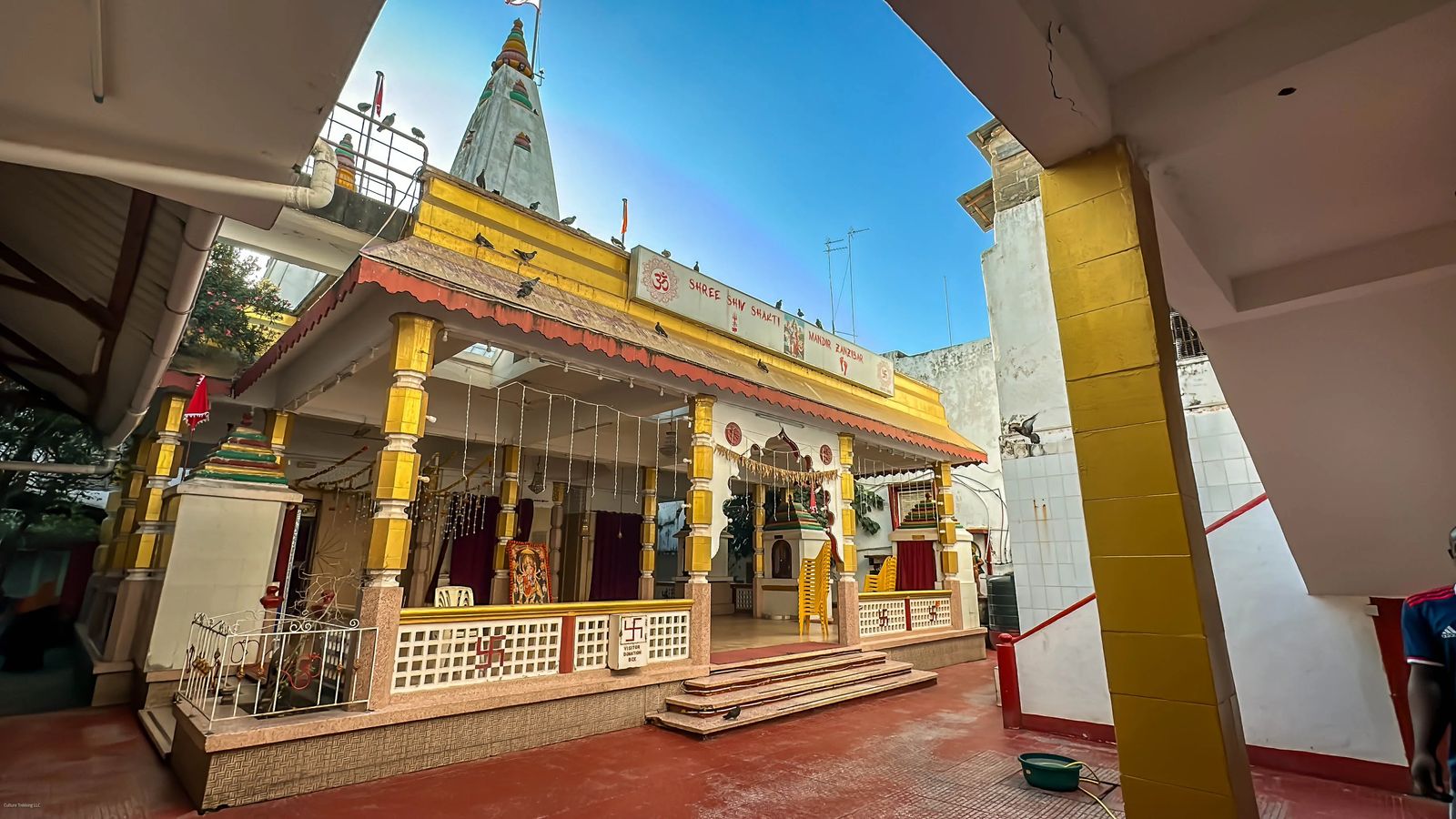
Shree Shiv Shakti Mandir Temple
Established in 1958 this is one of 2 temples in Zanzibar. Hinduism here dates clear back to the 1st century BC and as you walk in to this temple you could be greeted with hundreds of Pigeons. In Hinduism Pigeons are believed to be an animal vessel for the goddess of passion and sensuality called Mata Rati. This goddess, is the consort for the god of Love Kamdeva - so many newly wed Hindu couples end up wearing some kind of pigeon pendant to ensure great love and happiness in their marriage.
This temple is a bit hard to find unless you have a local with you as there are only a few small signs you can miss if you aren't looking for them. Hindusim is considered a minority religion in Zanzibar, but I was impressed at (from what I could tell by my brief visit) there is a religious tolerance in Zanzibar amongst all the different religious sects.
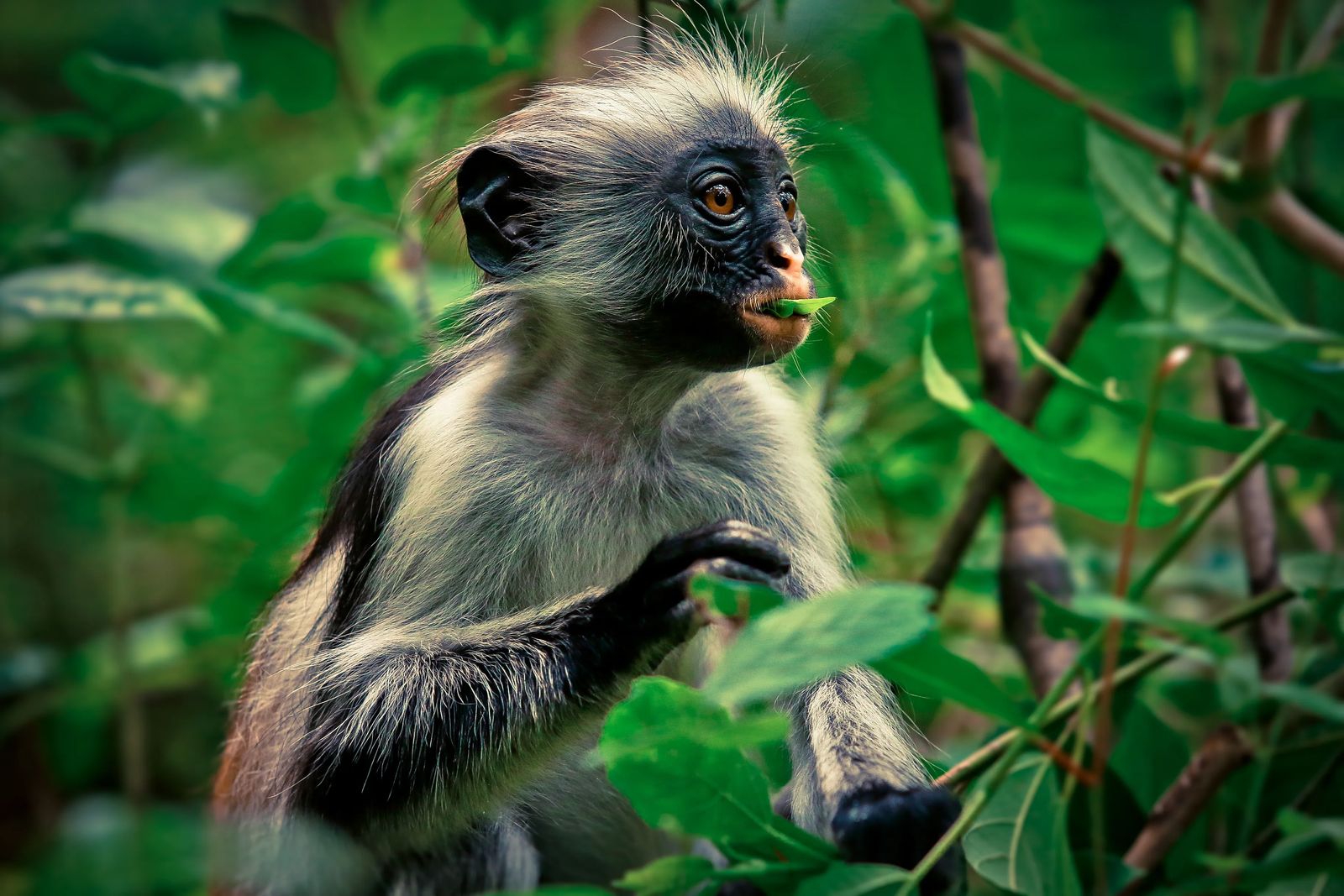
Jozani Forest
I was primarily in Zanzibar for a week long Scuba Diving trip in Nungwi, so I didn't get a chance to head out to Jozani Forest. I would try to book your tour through your hotel to ensure you are back in time, and have a guide with adequate knowledge of the land (often ones the hotel refers you to are registered guides and have nametags).
The Jozani Forest was protected in the 1960's to set up a place for the rare Kirk's Red Colobus Monkey. There are also beautiful mangroves you can wander through, but after talking to a few of my fellow travel companions - it is a hit or miss on if it is worth it. If you can find a guide that is knowledgable about the plants/animals, is interested in helping you have a good time - then it may be worth a visit if you have some extra time. There are some reports as well about it being smaller than expected, and visitors/tourists aren't as regulated as they maybe should be and some get too close to the monkeys which can swipe things from you if you aren't careful.
That being said, if you decide to visit, just make sure you are confident in your guide, clearly lay out expectations, and arrive early as you can to avoid crowds and get the best experience.
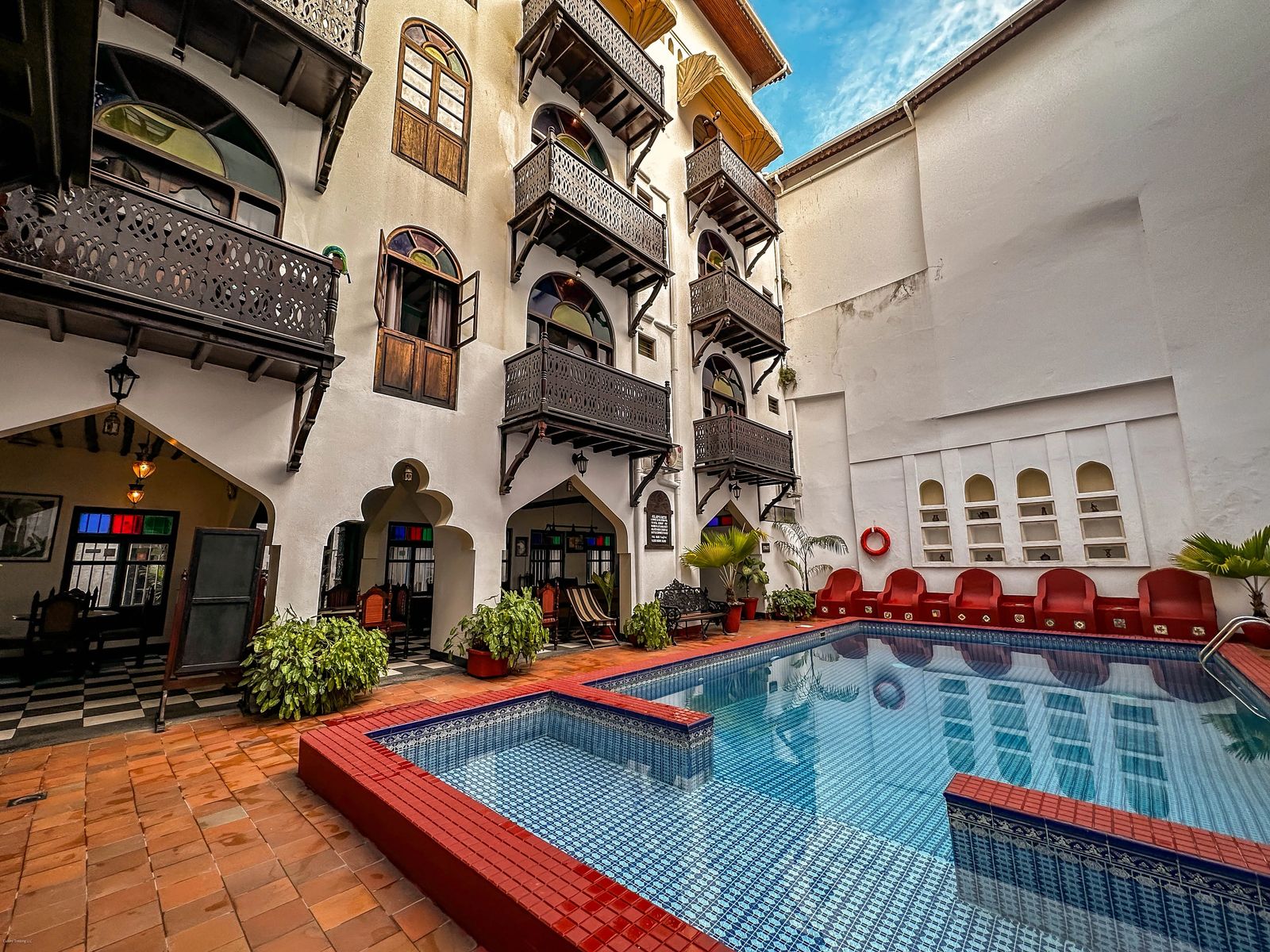
Dhow Palace Hotel
Dhow Palace was originally built in 1559 by Sheikh Mushin bin Mujiba whose family lived here for nearly 300 years. Then it was taken over by a Somali Clan leader, then the government, then finally Muzammil bought the dilapidated building and spent 6 years restoring it.
Muzammil was adamant that each element of the building was built using the same techniques that the hotel was originally built in. If you walk into the entryway, just before getting to the pool, you can see an exposed section of the hotel wall where coral was used to strengthen the walls - like it was with many of the buildings in the 16th century here.
Staying in this hotel, you can wander the different floors which can become a bit of a maze, but the central pool area helps you keep your bearings. There are so many patios, alleyways, side rooms and stairs. I would suggest requesting a room on the 1st-3rd floor specifically asking for a room with elevator access, if you have heavy luggage. They do have people that can help you bring your luggage to your room, make sure to tip them $1-$2 for the help.
Throughout the hotel you can find various Omani and Swahili antiques, even the doors have the old locking mechanims. I spent an entire morning going around the hotel, after the delicious breakfast they offer, looking at old locks, maps, pictures, musical instruments and more.
If you get a chance to stay here, it also located in a central area of stonetown. They have refrigerators in the rooms, 2 bottles of fresh water included each day, hot showers, and nice cold AC and pool.

Tembo House Hotel
Tembo House Hotel is located right on the beach and is more of an upscale stay (along with that cost) than Dhow Palace. It doesn't have the unique antiques, or unique layout that Dhow Palace does, but is a great option to stay at in Stonetown if for nothing else than the view of the beach. They offer breakfast on a terrace overlooking he beach and a small infinity pool overlooking the beach for the best way to experience the sunset in peace.
While it may not be as old as Dhow Palace, it does have a bit of important history associated with it having once housed the American Consulate, British Consulate, trading offices for Cowasjee Dinshaw, and Port of Suez headquarters.
Celebrities like Mahatma Ghandi, Freddie Mercury and Dr Livingstones body on his way back to England after passing away from Malaria.
It is only 15 minutes from the Airport, and 5 minutes from the port of Zanzibar.
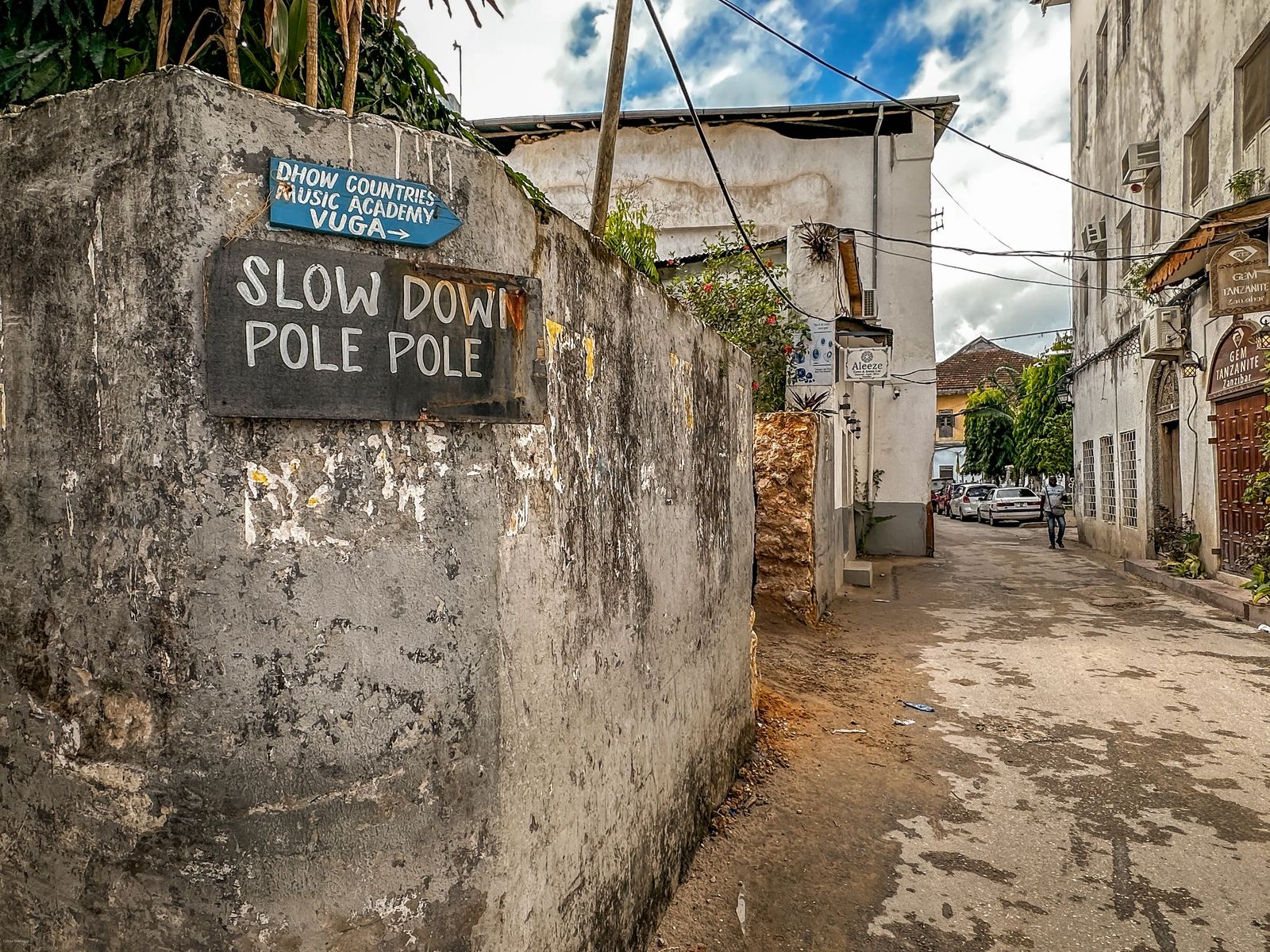
Getting To Zanzibar & VISA's for Americans
Major airways that come through Zanzibar are KLM, Qatar, Turkish, FlyDubai, Oman, Kenyan, Ethiopian, Jetway and Mango Airlines all travel through here. I booked on Delta and had a layover in Dar es Saalam where there was an odd de-boarding/cleaning/reboarding that happened - but was fairly seamless - but after 24 hours in airports it felt like an eternity.
There is a ferry that travels four times a day from Dar es Salaam to Zanzibar, and only cost about $35 for a 2 hour boat ride across some incredible blue waters.
You want to try and reserve a taxi from the airport to your hotel before arriving just in case you arrive late. Keep in mind that you may need to carry your bags to the front of your hotel and the roads aren't smooth and frequently have large pot holes. My suggestion is to get a soft sided luggage bag with backpack straps with the option to roll it, here is the one I used. While it was a bit messy inside, it worked really well for my needs and used my clothes as padding for anything breakable and packing cubes for everything else. If you go on a safari in Tanzania before or after Zanzibar you are required to have soft sided luggage so keep that in mind.
For American citizens you WILL need a VISA to enter Tanzania, which does cover Zanzibar for now. You can either pay at the airport when you land (pay cash to avoid issues with your card) or you can pay online (which is what I did). When you go to book your eVISA make sure you are on a website that is legitimate and a government site - not a convenience site, or knock off site saying it is official. I used this website, and had no troubles at the border crossing in Tanzania to Zanzibar, back to Tanzania, and back to Zanzibar. While it says it has a short turn around time, I would plan on at least 1 month in advance if you plan to do it online - just to make sure.
I would also print off all your boarding passes before leaving, service can be a bit spotting and so can the Wifi - so go old school and print off all your confirmations and emails - many locals in the remote areas GREATLY appreciate this.
When you get the airport and go to claim your luggage, there are LOTS of men there (especailly to my female solo travelers) that want to help you. This help is often asked with a tip of $2-$5 and because of the male role and masculine roles they take on - I would just plan on having them help you with your bags. They are ok accepting American Dollars, but I would tip on the lower end of the American Dollar as the exchange rate is really beneficial for them. Make sure to have LOTS of small bills though, you will tip a lot, and a technique for higher pay is to not offer change - but this is with both local currency and American dollars (at least what I observed).
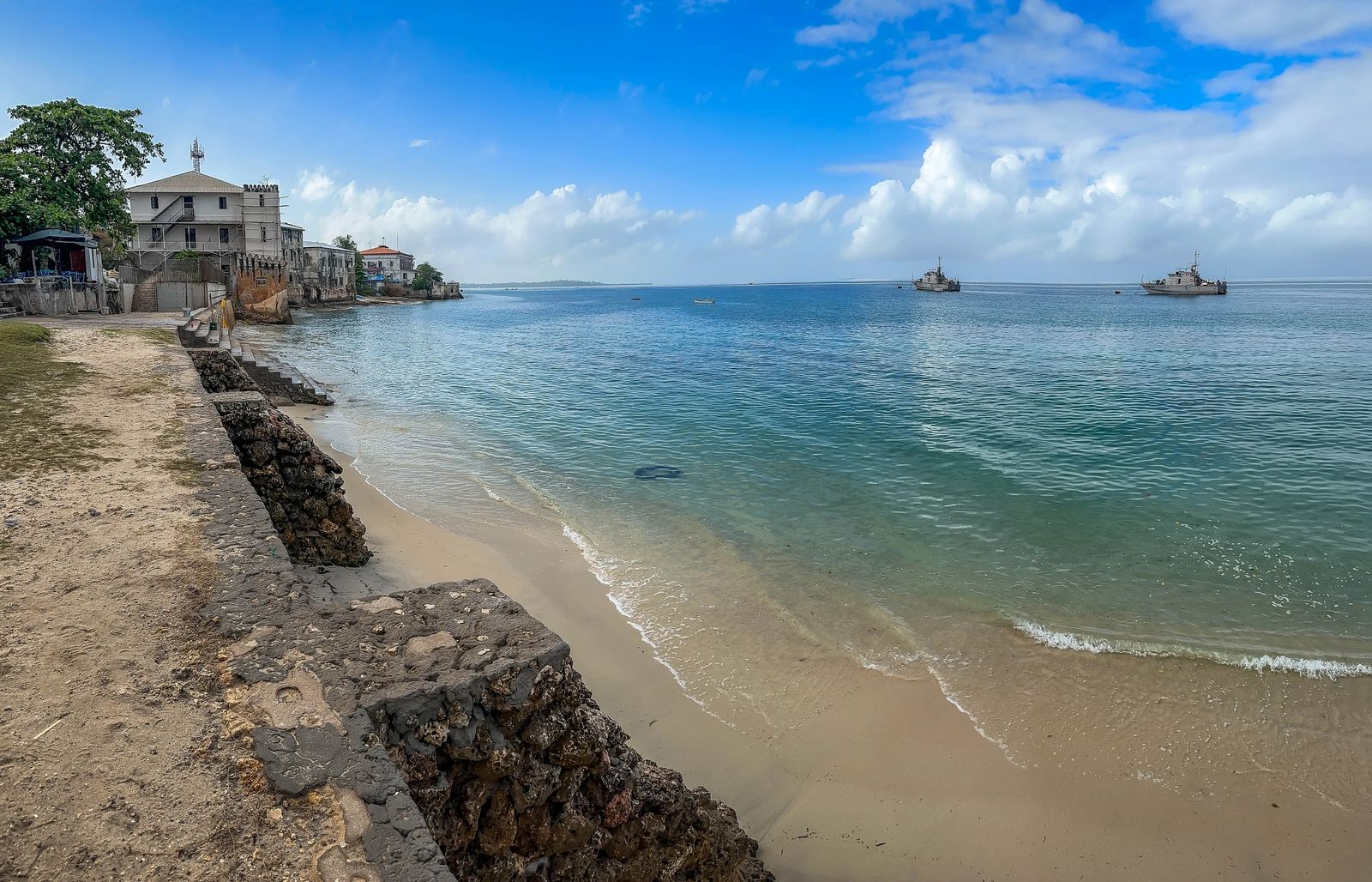
My Takeaway of Stonetown - Would I Visit Again?
The feeling of community in Zanzibar, especially in Nungwi was incredible and something that still makes me a bit emotional thinking about. I really enjoyed learning about the history in Stonetown especially how the enslaved were impacted here. The spice tour was SO MUCH FUN! If I go back with a group or even again to scuba dive I would ABSOLUTELY do that tour. I definitely learned A LOT more by having a guide through Stonetown vs when I tried to do it on my own or by my own research.
I would definitely get a hotel close to town as public bathrooms aren't easily found, access to clean water and just a little reprieve from the heat to cool down was well worth the cost.
If I were to do this trip over again, I would try to allot more time to finding reliable places to eat, spend more time at the beach, and allotting more time to do the Stonetown tour - I only had 2 hours and they typically do it in 4 hours.
All in all I really enjoyed my time in Stonetown, there was a touch of culture shock, but I've traveled enough places to be able to remove my 'first world glasses' of what I'm used to seeing as 'comfortable' and embrace what is.
If you are female and visiting I highly suggest wearing things in town that cover the cleavage, shoulders and shorts to the knees - unless you are comfortable with male stares. Stonetown is safe if you are smart, but I was told to not travel alone at night if I could help it - especially near Foradani Gardens.
I hope you have an amazing trip and let me know in the comments if you have any questions before visiting.
Happy and safe travels my friends!
Guided Tours of Stone Town
I personally used a man named Ali, he was very knowledgable and was able to help me see Stonetown in half the time he usually takes people around to see it. If you would like to book with him contact him via email at mudhhir40@gmail.com or via WhatsApp +255 777 120 259
Where to stay in StoneTown
Like it? Pin it for later! Sharing is caring ;)
.jpg?fit=outside&w=1600&h=2399)
.jpg?fit=outside&w=1600&h=2399)
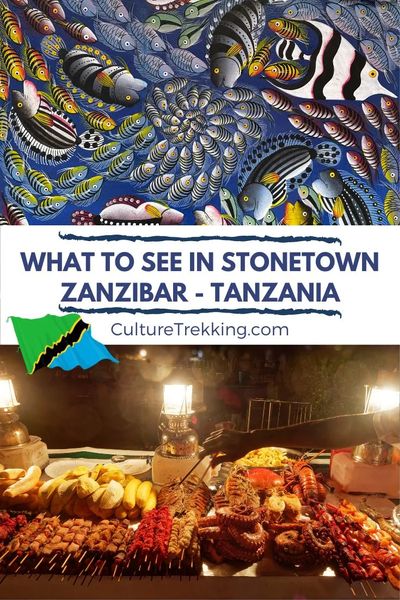.jpg?fit=outside&w=1600&h=2399)

Latest Articles On Culture Trekking
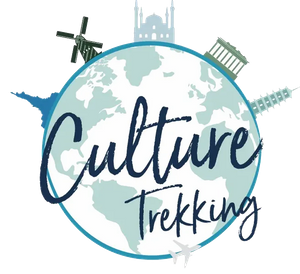

Welcome to Culture Trekking!
My name is Janiel, a leader in the travel industry with over 20+ years of experience with international travel. I specialize in solo female travel, cultural connections, sustainable adventures, food and history to help make your travel experiences fun, meaningful, and delicious. My experience in travel, and my personal story have allowed me to get published in Fodor's Travel, Atlas Obscura, Metro.co.uk, Trip Advisor, and multiple Podcast interviews. You can find me on pretty much every social media channel YouTube, Instagram, Twitter, Facebook, Pinterest, TikTok. To read more about me and my story click here. If you are a brand and would like to work with me, click here.















